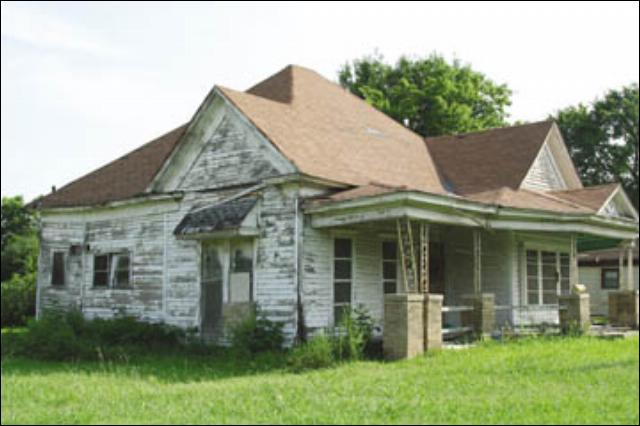|

Saving History
G.W. Jackson House receives national grant
By Janet Jacobs
For years, the former G.W. Jackson house at the corner of Martin Luther King
Blvd. and Fifth Street has slumbered, getting more and more bedraggled until
this last year, when the Planning and Zoning Commission ordered it demolished.
Now, the National Trust for Historic Preservation, a national non-profit group
which helps local communities save American history, has offered to pay for an
expert to come in, assess the project, and recommend a plan of action.
“When the demolition order was issued early this year, it got everyone’s
attention,” said Malinda Sharpley, Main Street director, who applied for the
grant. “The city stayed the order until December, which has given us time to put
things in order and come up with a plan of action.”
Daniel Carey, director of the Southwest Office of the National Trust, called
with the news Tuesday.
“We recognized its importance, and thought we had to do something,” Carey said
in a phone interview from his office in Fort Worth. “We determined we should
hire a structural engineer who understands historic resources to help determine
a course of repair and rehabilitation. We’re fortunate we have an intervention
fund that’s supported by the Summerlee Foundation in Dallas.”
Doing the work will be Steve Lucy, a structural engineer with the Dallas firm of
Jaster-Quintanilla. Carey estimated the assessment and study would cost around
$2,000-3,000.
“It varies from case to case,” he said. “It’s difficult to say what this may
run, but my guess is several thousand dollars, which is just part of what we at
the National Trust do to help communities save historic resources that matter to
them.”
When historic structures fall into a crisis situation, like the Governor’s
Mansion which was recently destroyed by arson, the knee-jerk reaction is to tear
the building down. However, the National Trust can offer expert advice and
funding to find ways to save these buildings, Carey said.
“That’s what we do with these grants, we just bring a little sense and
sensibility to the process,” he added.
The G.W. Jackson home was built around 1900, and is now owned by Lois Jean Hart,
a former educator herself, who envisioned rescuing the building. As her health
declined, the work fell to the wayside and the house fell further into
disrepair. This year, a new committee has formed to help steer the project into
the future. Committee members include Ruby Williams, Gwen Chance, Malinda
Sharpley, Elmeree Burrell, Brad Cook, Aaron Myers, and Bobbie Young.
“The house has become dilapidated,” Williams said. “But it’s the only link we
have to our G.W. Jackson School heritage.”
The local history of schools for black students stretches back to the 1870s, and
G.W. Jackson was the first principal of what was first called the Negro School,
then the Fred Douglass School. The name of the school was changed in 1925 to
honor Jackson, who was by then a fixture for progressive education in the
county.
A disciple of Booker T. Washington, Jackson believed the students needed a solid
education along with a trade, and his school taught both. It was so much ahead
of its time that newspaper accounts of the early 1900s said that students from
Dallas rode the railcars to Corsicana to school because there weren’t comparable
schools for them in that city.
Jackson was born in 1854 in Alabama, and died in 1940.
Desegregation finally ended G.W. Jackson School, which burned and was
finally razed in 1974. The new Boys and Girls Club is built approximately where
the school was once located.
The committee is interested in seeing this last remnant of the school and its
founder turned into a museum, Williams said.
“We wanted to show, and have something here to show G.W. Jackson had been an
important school,” she said. “We’re also collecting old memorabilia from G.W.
Jackson, asking people if they have anything from that house or pertaining to
G.W. Jackson school or pictures. We want to make it a useful building for the
Corsicana area, not just Precinct 2.”
Williams acknowledged that raising the money for the rehabilitation work would
be the biggest obstacle.
Carey said that the fact that there are so few surviving structures from the
African American history makes it that much more important to preserve this one.
“It brings to light a resource that may have been overlooked, and now people see
it in a new way,” Carey said. “People may say ‘we didn’t realize the history of
this building, or its significance.’ Everybody in the community, not just one
group, develops a deeper appreciation for the resource, whatever it is.”
Having it recognized as nationally important may help in the fund-raising, he
added.
“What we find is that historic buildings don’t have color,” Carey said. “They
have history and architecture and meaning for people in the community. When
people recognize that, they rally around it.”
Notes:
|